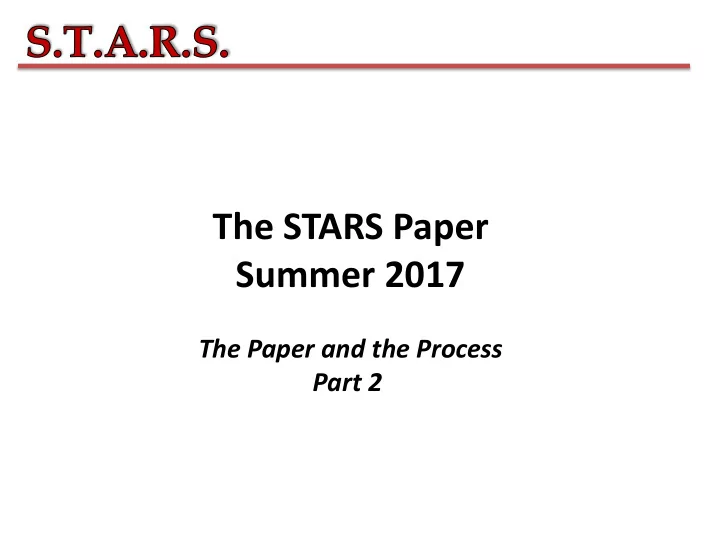

The STARS Paper Summer 2017 The Paper and the Process Part 2
The Paper Components of the Paper Abstract: Typically 100-250 words. Consists of purpose, method, results and conclusion. Introduction: Introduces topic and issue. Summarizes relevant literature. States the approach used and results obtained. Materials & Methods: Lists reagents used and where purchased. Methods are specific and direct. Can be either as seen in published papers or in protocol format based on what your Mentor prefers. It is ok to use a previously published methods as long as they are referenced
The Paper Components of the Paper (continued) Results: The meat of the paper. Includes all relevant data but be concise. Work closely with your Mentor in the presentation /formatting of the results…Figures included. Discussion: Relate results to original question/issue. Interpretations encouraged. Discuss potential future experiments. References: Recommended format is to list references alphabetically but may change based on Mentor’s request. Be sure to include: authors, year, title of article, journal, volume and pages. Acknowledgements: Very important section of STARS paper....where you thank your Mentor and the lab members for sharing of their time and talents with you.
The Process Schedule for Paper – what needs to be sent to your STARS advisor and lab rep and when Week 1: Due 6/16 Proposal – short and sweet I will be studying ……. The approach I will be using is …… Week 2: Due 6/23 Start of Introduction /References (not complete...just a start) Week 3: Due 6/30 Add Materials and Methods (continue to work on Intro & References) Week 4: Due 7/7 Add beginnings of Results and Discussion (continue working on other sections) Week 5: Due 7/14 Add ABSTRACT – close to complete Week 6: Due 7/21 Paper Complete. MUST have mentor sign off on it!
The Introduction.... Why is this important What is already known The focus of this work The approach being used The results (simply stated) Use previously published papers from your mentor/lab as a guide
The Materials & Methods.... List of reagents – be specific Use previously published papers as a guide Keep it unambiguous (concentrations, g force etc) It is OK to use a previously published method Just be sure to provide the reference Use previously published papers as a guide (I just had to say it again)
The Materials & Methods.... In well written methods there is no ambiguity as to what you did. Typically stating final concentrations is the clearest but do as your mentor prefers. Format typically used in a paper… Kinase Activity Assay. A resin capture assay method was used to determine the phosphorylation of epidermal growth factor receptor peptide (EGFRP) or GST-c-Jun by p38 kinases or JNK2, respectively. Reactions mixtures contained 25 mM HEPES, pH 7.5, 10 mM magnesium acetate, ATP (at the indicated concentration), 0.05 to 0.3 m Ci of [ g -33P]ATP, 0.8 mM dithiothreitol, and either 200 m M EGFRP or 10 m MGST-c-Jun for p38 a kinase or JNK2 reactions, respectively. The reaction was initiated by the addition of either 25 nM p38 kinase or 100 nM JNK2 to give a final volume of 50 m l. The JNK2 and p38 a kinase reactions were incubated at 25°C for either 20 or 30 min, respectively.
The Materials & Methods.... Protocol Format… Pierce BCA Assay Protocol for microplate format: 1. Prepare Working Reagent (WR) by mixing 50 parts of BCA Reagent A with 1 part of BCA Reagent B (50:1, Reagent A:B). 2. Pipette 25μL of each standard or unknown sample replicate into a microplate well (working range = 20- 2000μg/mL). 3. Add 200μLof the WR to each well and mix plate thoroughly on a plate shaker for 30 seconds. 4. Cover plate and incubate at 37°C for 30 minutes. 5. Cool plate to RT. 6. Measure the absorbance at or near 562nm on a plate reader. Once again….. do these as your mentor prefers.
Results Section…..the words: • Clear, direct & succinct. • Minimal if any ‘what this might mean’…save that for the Discussion • Definitely work with your mentor on how to present the data…must be as they want it! Results Section…..the Figures: • All figures go in order at the end of your paper. • One figure plus corresponding figure legend per page at the end of your paper. • No embedded figures in your text. • Figures should be clear and well labeled. • No fancy artsy stuff (3D, colors only if necessary) • Figure legend should state what the figure is telling the reader.
Figure 4: Compound X Inhibits Cytokine Production in LPS challenged human peripheral blood mononuclear cells (PBMC) in the low nM range. Cells were preincubated with Compound X for 60 min, challenged with LPS, then medium was collected to determine cytokine (TNF a , IL8, IL6 and IL1 b ) release by Meso Scale technology. Data are averages from 3 donors. Curve fit, IC 50 determinations, and standard errors (SEs) were made using Grafit 5 software.
The References.... By number in text or by alphabetical order…whatever your mentor prefers. Include: authors, year, title, journal, volume, pages 1. Jackman KA, Miller AA, Drummond GR, Sobey CG (2009) Importance of NOX1 for angiotensin II-induced cerebrovascular superoxide production and cortical infarct volume following ischemic stroke. Brain Res 1286: 215-220. 2. Baylis C (2008) Nitric oxide deficiency in chronic kidney disease. Am J Physiol Renal Physiol 294: F1-9. 3. Greenman IC, Gomez E, Moore CE, Herbert TP (2007) Distinct glucose-dependent stress responses revealed by translational profiling in pancreatic beta-cells. J Endocrinol 192: 179-187. Or Baylis C (2008) Nitric oxide deficiency in chronic kidney disease. Am J Physiol Renal Physiol 294: F1-9. Greenman IC, Gomez E, Moore CE, Herbert TP (2007) Distinct glucose-dependent stress responses revealed by translational profiling in pancreatic beta-cells. J Endocrinol 192: 179-187. Jackman KA, Miller AA, Drummond GR, Sobey CG (2009) Importance of NOX1 for angiotensin II-induced cerebrovascular superoxide production and cortical infarct volume following ischemic stroke. Brain Res 1286: 215-220. NO WIKI or WEBSITES!!
Recommend
More recommend